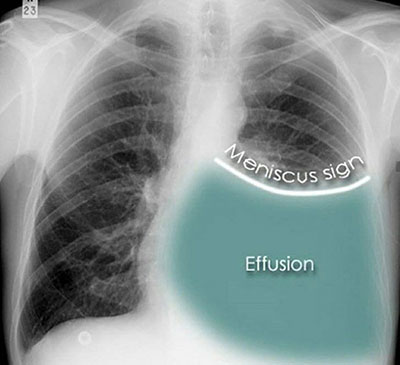Pleural Effusion sometimes referred to as "water in the lungs," is the build-up of excess fluid between the layers of the pleura outside the lungs. The pleura are thin membranes that line the lungs and the inside of the chest cavity and act to lubricate and facilitate breathing. Normally, a small amount of fluid is present in the pleura.

The tests most commonly used to diagnose and evaluate pleural effusion include:
Dr. Indu Bubna –Chest Specialist in Mumbai will suggest the best treatment plan
Pleural effusion: This is excess fluid in the pleural cavity. This is one of the most common problems associated with the pleura. The most common cause is congestive heart failure. Other causes include lung cancer, pneumonia, tuberculosis, liver disease, pulmonary embolism. Pleural effusion generally causes no symptoms and, by itself, is not serious.
Hemothorax: is a buildup of blood in the pleural cavity. Chest trauma due to the accident is the most common cause, but cancer of the lung or pleura or open-heart surgery can also cause a hemothorax.
Empyema: The accumulation of pus in the pleural cavity. This is a type of pleural effusion that is usually associated with pneumonia. The symptoms are those of pneumonia (cough, fever) in addition to shortness of breath and impaired breathing.
Pleural tumors: Pleural tumors are cancerous tissues in the pleural cavity. Usually, pleural tumors are cancers that have spread from other areas of the body. Symptoms: Shortness of breath, chest pain, cough, unexpected weight loss
Pleurisy is pain associated with inflammation of the pleural cavity. The most common cause is a viral infection, such as influenza. Other causes include bacterial and fungal infections, lung cancer, other diseases such as rheumatoid arthritis and mesothelioma, and reaction to certain medications. Symptoms of pleurisy may include a sharp pain when breathing, shortness of breath, a cough, fever and chills, rapid breathing, unexplained weight loss, and sore throat followed by joint swelling and soreness.
Pneumothorax is a buildup of air or gas in the pleural cavity around the lung that causes the lung to collapse. Chronic obstructive pulmonary disease, tuberculosis, and trauma are the most common causes. Symptoms: Shortness of breath, rapid breathing, chest pain when taking a deep breath (pleurisy), cyanosis (bluish discoloration of the skin), respiratory distress if large
